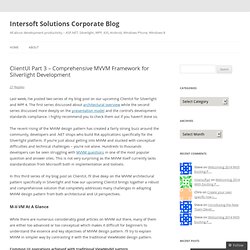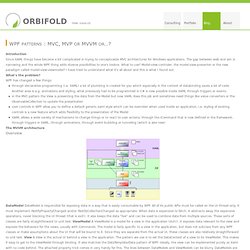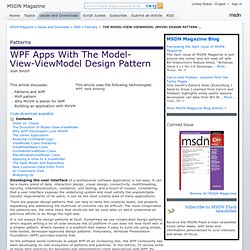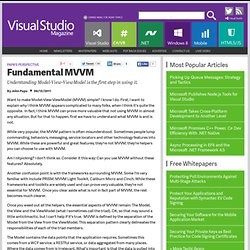

ClientUI Part 3 – Comprehensive MVVM Framework for Silverlight Development. Last week, I’ve posted two series of my blog post on our upcoming ClientUI for Silverlight and WPF 4.

The first series discussed about architectural overview while the second series discussed more deeply on the presentation model and the control’s development standards compliance. I highly recommend you to check them out if you haven’t done so. The recent rising of the MVVM design pattern has created a fairly strong buzz around the community, developers and .NET shops who build RIA applications specifically for the Silverlight platform. If you’re just about getting into MVVM and stucked with conceptual difficulties and technical challenges – you’re not alone.
Hundreds to thousands developers can be seen struggling with MVVM questions in one of the most popular question and answer sites. M-V-VM At A Glance Common UI operations achieved with traditional ViewModel pattern. Model-View-ViewModel (MVVM) Explained. The purpose of this post is to provide an introduction to the Model-View-ViewModel (MVVM) pattern.

While I've participated in lots of discussions online about MVVM, it occurred to me that beginners who are learning the pattern have very little to go on and a lot of conflicting resources to wade through in order to try to implement it in their own code. I am not trying to introduce dogma but wanted to pull together key concepts in a single post to make it easy and straightforward to understand the value of the pattern and how it can be implemented. MVVM is really far simpler than people make it out to be. WPF patterns : MVC, MVP or MVVM or…? Introduction Since XAML things have become a bit complicated in trying to conceptualize MVC architectures for Windows applications.

The gap between web and win is narrowing and the whole WPF thing adds diverse possibilities to one's toobox. What to use? Model-view-controler, the model-view-presenter or the new paradigm called model-view-viewmodel? I have tried to understand what it's all about and this is what I found out. What's the problem? WPF has changed a few things: through declarative programming (i.e.
THE MODEL-VIEW-VIEWMODEL (MVVM) DESIGN PATTERN FOR WPF. Patterns WPF Apps With The Model-View-ViewModel Design Pattern Josh Smith Developing the user interface of a professional software application is not easy.

It can be a murky blend of data, interaction design, visual design, connectivity, multithreading, security, internationalization, validation, unit testing, and a touch of voodoo. Considering that a user interface exposes the underlying system and must satisfy the unpredictable stylistic requirements of its users, it can be the most volatile area of many applications. There are popular design patterns that can help to tame this unwieldy beast, but properly separating and addressing the multitude of concerns can be difficult. It is not always the design patterns at fault. As the software world continues to adopt WPF at an increasing rate, the WPF community has been developing its own ecosystem of patterns and practices. Order vs. It is unnecessary and counterproductive to use design patterns in a simple "Hello, World!
" Figure 1 Workspaces. Fundamental MVVM. Papa's Perspective.

Joel in point form » MVVM vs MVP vs MVC: The differences explained » Joel. For the consicise explanation, see MVVM vs MVP vs MVC: The concise explanation Those who know me know that I have a passion for software architecture and after developing projects using Model-View-ViewModel (MVVM), Model-View-Presenter (MVP), and Model-View-Controller (MVC), I finally feel qualified to talk about the differences between these architectures.

The goal of this article is to clearly explain the differences between these 3 architectures. First, the let’s define common elements. Overview of the ModelView – ViewModel (MVVM) pattern and data-binding « Russell East’s blog. In my own learning of WPF or any technology that I learn, I use the same approach and design principles that I would for a technology I know inside out.

MVC vs. MVP vs. MVVM « Niraj Bhatt – Architect's Blog. An important FAQ.

The answer actually depends on where the person is coming from. MVC is a fundamental pattern which has been tweaked quite a bit to fit into various platforms. For instance if you had asked anybody how to implement an MVC in ASP.NET (prior to release of ASP.NET MVC framework) you would get very different answers. So let’s start with basic. The common motivation behind all 3 is separation of concerns, cutting flab from UI (good for UI designers), swapping UIs (for instance windows to web), make UI easy for Unit Testing, etc.
MVC: Three components – View (your UI), Model (your business entities / data – that view is displaying) & Controller (contains the logic that alters the model depending on the action triggered by UI, typically implementing a Use Case). MVP: Again three components. Supervising Controller uses a controller both to handle input response but also to manipulate the view to handle more complex view logic. Digg Like this: Like Loading...